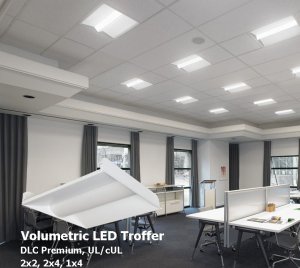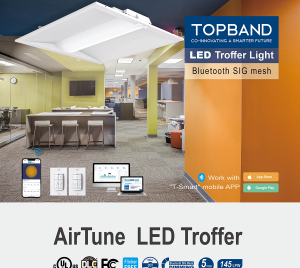Troffer lights are a type of lighting fixture commonly found in commercial and institutional buildings. They are typically rectangular or square in shape and are designed to fit into modular dropped ceilings, although they can also be surface-mounted or suspended. Troffer lights are specifically designed to fit into modular dropped ceilings. These ceilings consist of a grid framework with removable ceiling tiles, often made of materials like gypsum or metal. Troffer lights are sized to fit neatly within the grid openings of these ceilings, providing a seamless appearance when installed. Although troffer lights are primarily intended for use in dropped ceilings, they offer versatility in installation. In addition to being recessed into dropped ceilings, they can also be surface-mounted directly onto ceilings or suspended from the ceiling using cables or chains. This flexibility in mounting options allows troffer lights to adapt to various architectural configurations and lighting requirements. Troffer lights are highly adaptable lighting fixtures commonly utilized in commercial and institutional settings. Their rectangular or square shape, compatibility with modular dropped ceilings, and versatile mounting options make them a practical choice for achieving uniform and efficient illumination in diverse indoor environments.
LED panel lights are indeed a type of troffer lighting fixture. They share many similarities with traditional troffer lights but have a slimmer profile compared to traditional troffer lights and produce uniform light distribution across the entire surface of the light panel. Both LED panel lights and traditional troffer lights are designed for drop ceilings and share similar installation methods. While both LED panel lights and troffer lights serve similar purposes and have similar form factors, they employ different optical configurations to achieve their lighting effects. LED panel lights incorporate advanced optical designs that include optics, reflectors, and diffusers to control the direction and distribution of light. The differences in optical configurations between LED panel lights and troffer lights can impact the quality and characteristics of the lighting they produce. Troffers often rely on reflectors and diffusers to distribute light evenly across the space beneath them. While effective, this method may not offer the same precision and control over light distribution as LED panel lights.
LED panel lights come in two main types: edge-lit and backlit. These distinctions refer to how the LEDs are positioned within the panel and how they illuminate the light guide plate, affecting the distribution and quality of light emitted by the fixture. In edge-lit LED panel lights, the LEDs are positioned along the edges of the panel, typically on one or more sides. Light emitted from these edge-mounted LEDs is directed into the light guide plate, which disperses the light evenly across the surface of the panel. The light guide plate may contain reflective materials or optical elements to help distribute the light more uniformly and reduce glare. Edge-lit panels are often thinner and lighter compared to backlit panels, making them suitable for applications where space constraints or aesthetic considerations are important. They generally produce a softer, more diffused light, which can be desirable for certain indoor environments such as offices, classrooms, and healthcare facilities. In backlit LED panel lights, the LEDs are positioned behind the light guide plate, illuminating it from the back. Backlit panels may incorporate additional optical elements such as diffusers or reflectors to enhance light distribution and minimize hotspots. While backlit panels may be slightly thicker than edge-lit panels due to the positioning of the LEDs, they still offer a sleek and modern appearance. Backlit panels are often preferred in applications where higher light output or more directional lighting is required, such as in retail spaces, galleries, or task lighting applications.
LED troffers and panels find applications in various commercial, institutional, and industrial settings due to their energy efficiency, versatility, and ability to provide uniform illumination. They are widely used in office buildings to provide general ambient lighting. They can create a well-lit and productive workspace for employees. LED troffers and panels are often installed in classrooms, corridors, and common areas in schools and educational institutions to ensure adequate lighting for learning environments. These fixtures can be installed in conference rooms to provide even illumination for presentations, meetings, and video conferencing. LED troffers and panels are suitable for hospitals, clinics, and medical offices where consistent, high-quality lighting is essential for patient care and staff productivity. LED troffers and panels can be used in retail environments to showcase merchandise and create a bright and inviting shopping atmosphere. LED troffers and panels are commonly found in lobbies, hallways, conference rooms, and other common areas of commercial buildings such as hotels, restaurants, and shopping malls. In industrial settings such as warehouses, factories, and manufacturing plants, LED troffers and panels provide efficient and durable lighting solutions for high-ceiling spaces.
The integration of LED technology in troffers expands the range of features, functionalities, and design options available for these lighting fixtures, offering improved energy efficiency, longevity, control, design flexibility, and performance compared to traditional lighting solutions. LED technology allows for smooth dimming of light output. Users can adjust the brightness level of troffers and panels to create the desired ambiance or adapt to changing lighting needs throughout the day. Dimming capabilities also contribute to energy savings by reducing power consumption when full brightness is not required. The spectral flexibility of LED technology empowers designers to explore tunable white lighting. Human-centric lighting takes into account the biological and psychological effects of light on human beings. It aims to enhance well-being, productivity, and comfort by mimicking natural daylight patterns or by adjusting the spectral content of light to support human circadian rhythms. Tunable white lighting allows designers to adjust the spectral content of light to align with human circadian rhythms and enhance visual comfort.
Some LED troffers and panels come equipped with programmable controls, enabling users to create customized lighting presets or schedules. This functionality is particularly useful in environments with varying usage patterns, such as offices, classrooms, or retail spaces. Users can program the lighting to automatically adjust according to occupancy, time of day, or specific activities, optimizing energy efficiency and user comfort. In larger spaces, LED troffers and panels may be grouped into zones, allowing for independent control of lighting in different areas. Users can adjust the lighting levels or turn off specific zones as needed, providing flexibility and customization based on occupancy or task requirements. LED troffers and panels can be integrated with smart lighting systems, enabling seamless control through smartphones, tablets, or other connected devices. Users can remotely adjust settings, monitor energy usage, or receive notifications about maintenance requirements, enhancing convenience and efficiency.






